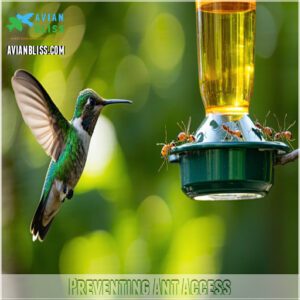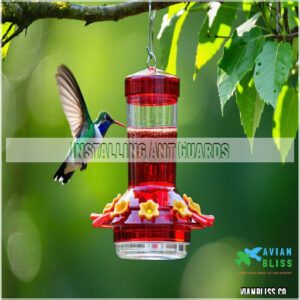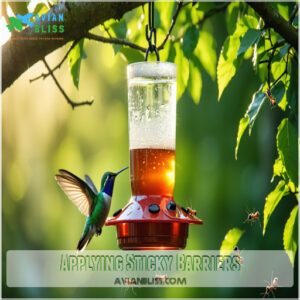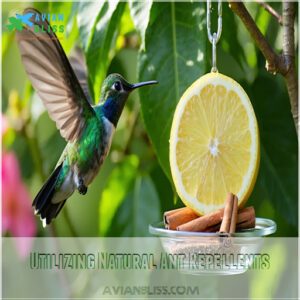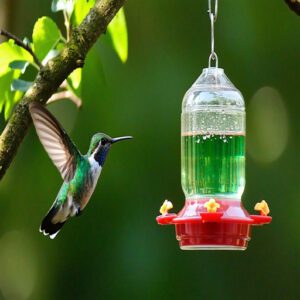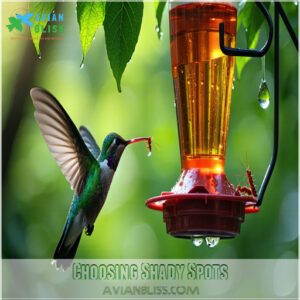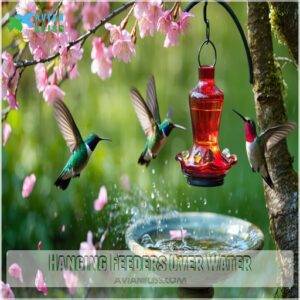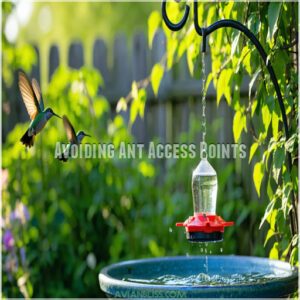This site is supported by our readers. We may earn a commission, at no cost to you, if you purchase through links.
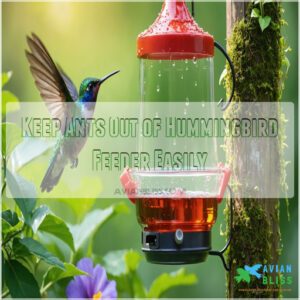
Check your feeder for leaks; ants love a sugary drip. Hang your feeder in a shady spot; this keeps the nectar fresh and less appealing to ants.
Regular cleaning also helps. Want more clever solutions to keep those tiny sugar fiends away? There’s more to discover.
Table Of Contents
- Key Takeaways
- Preventing Ant Access
- Ant Barriers and Deterrents
- Feeder Maintenance Tips
- Strategic Feeder Placement
- Natural Ant Repellent Methods
- Frequently Asked Questions (FAQs)
- How do I keep ants off my hummingbird feeder?
- Why do you put aluminum foil on hummingbird feeders?
- Will vaseline keep ants away?
- Can I spray vinegar on my hummingbird feeder?
- How do you keep ants out of a hummingbird feeder?
- How to deter bees from hummingbird feeders?
- Do hummingbird feeders have ant moats?
- How to clean a hummingbird feeder?
- What keeps ants off hummingbird feeders?
- What attracts ants to hummingbird feeders initially?
- Conclusion
Key Takeaways
- You can stop ants from reaching your hummingbird feeder with an ant moat, a small cup of water that hangs above the feeder. Ants cannot cross the water barrier.
- Keep your feeder clean and free of leaks. Ants love sugary drips and residue. Regular cleaning helps prevent infestations.
- Hang your feeder in a shady spot. This keeps the nectar fresh and less attractive to ants. It also provides a comfortable environment for the hummingbirds.
- Use natural ant repellents. Cinnamon, essential oils, and mint can deter ants without harming hummingbirds. You can also make a natural ant repellent spray with vinegar and water.
Preventing Ant Access
You can prevent ants from getting to your hummingbird feeder by taking a few simple steps.
By inspecting your feeder for leaks, positioning it in partial shade, and using the right nectar recipe, you’re already on your way to keeping those pesky ants out.
This approach helps in preventing ants from accessing the feeder, thus protecting the hummingbirds’ food source.
Inspecting Feeders for Leaks
Check your hummingbird feeder for leaks to prevent ants.
Finding leaks is key.
Patching them is easy.
Test for leaks regularly to prevent ants from getting in.
Clean the feeder and check for cracks to prevent leaks and keep ants out, ensuring a safe and ant-free hummingbird feeder.
Positioning Feeders in Partial Shade
Position your hummingbird feeder in partial shade to reduce nectar fermentation.
Shade benefits include lower nectar temperature, slowing down fermentation.
This placement strategy helps, so move your feeder to a shadier spot to keep ants away and your hummingbirds happy.
Regularly Relocating Feeders
You can disrupt ant trails by relocating your feeder regularly, confusing their navigation and scent trail disruption.
Vary feeder locations for unpredictable placement, keeping ants out. Move your feeder, hang it above water, and consider an ant guard to prevent ants from reaching the nectar.
Effective ant prevention methods include using an ant moat system to stop ants from accessing the feeder, which is a key part of hummingbird feeder maintenance and ensuring ant-free feeding.
Using Hummingbird Nectar Recipes
Making your own hummingbird nectar is easy! A simple homemade hummingbird nectar recipe uses refined white sugar, not honey or other sweeteners, which can harm hummingbirds.
The right nectar concentration keeps ants away. Consider using effective ant moats to prevent ant access. Boiling nectar helps it dissolve and last longer.
- One part sugar to four parts water is the classic recipe.
- Avoid using nectar alternatives or sugar water with natural ant attractants.
- Cool and fill your feeder with your homemade hummingbird nectar.
- Change the nectar every few days, especially in warm weather, to prevent attracting ants in hummingbird food.
Ant Barriers and Deterrents
You can keep ants out of your hummingbird feeder by using ant barriers and deterrents, which are simple and effective methods.
By installing ant guards, using ant moats, or applying sticky barriers, you’ll be able to prevent ants from reaching the feeder and enjoying the nectar.
Installing Ant Guards
You’re taking steps to prevent ant access, now install ant guards to block their path.
Ants can contaminate nectar, potentially harming hummingbirds, so consider effective ant prevention methods.
Use a hummingbird feeder ant guard or DIY one with a moat, placing it above the feeder to stop ants from crossing, ensuring a safe haven for hummingbirds to feed, which is crucial for their well-being and to prevent them from being harmed.
Using Ant Moats
You can use an ant moat, a small water-filled barrier, to keep ants away from your hummingbird feeder, placing it above or below the feeder.
Refill it regularly for effectiveness, considering DIY or commercial moat types, like a hummingbird ant moat.
Helpful products for a hummingbird ant moat setup are available online, which can be a useful resource for an effective moat setup.
Applying Sticky Barriers
Sticky barrier types like Tanglefoot, petroleum jelly, or a vaseline sugar ants hummingbird feeder grease barrier can stop ants.
You can buy Tanglefoot ant barrier products. Apply these sticky barrier techniques above the feeding ports.
- Keep it away from where hummingbirds feed.
- Consider placement strategies to maximize effectiveness.
- Safe usage means avoiding contact with birds.
- Regular barrier maintenance is key.
- Replace sticky barriers as needed.
Utilizing Natural Ant Repellents
Try using essential oils, cinnamon, or mint to repel ants.
You can also sprinkle diatomaceous earth or place citrus peels near your feeder.
Mix vinegar with water for a natural ant repellent spray, or use lemon water to keep ants away from your hummingbird feeder.
Feeder Maintenance Tips
You can keep ants out of your hummingbird feeder by following some simple maintenance tips.
By cleaning your feeder regularly, inspecting it for damage, and replacing it when needed, you’ll be able to prevent ants from taking over and keep your hummingbirds happy and healthy.
This will help maintain a clean and safe environment for the birds, and by doing so, you ensure they have a reliable source of food, which is crucial for their survival, and this can be achieved by following these simple maintenance tips.
Frequent Cleaning and Hygiene
Besides barriers, hummingbird feeder care relies on cleanliness. Daily cleaning keeps sugar residue from becoming an ant buffet.
Cleaning feeder with mild soap and water works, but vinegar cleaning is a natural powerhouse. Thorough drying prevents mold.
Regular feeder maintenance, including leak prevention, is key. This simple cleaning tips routine keeps your hummingbirds happy and ants away.
Replacing Old Feeders
Keeping your hummingbird feeder sparkling clean is great, but sometimes you need a fresh start. Consider replacing cracked, leaky, or moldy feeders.
Here’s why: 1. Damaged feeders attract ants.
- Leaky feeders waste nectar.
- Moldy feeders harm hummingbirds.
Look for an ant-proof or ant-resistant hummingbird feeder to make life easier. You can find hummingbird feeder replacements online.
Knowing the feeder lifespan helps you decide when it’s time for a new best ant-proof hummingbird feeder. Replacing old feeders is key to happy hummingbirds!
Regular Inspection for Damage
Beyond simply replacing your feeder, regular checks are key. Inspect your feeder often for cracks and leaks – that’s Leak Detection 101.
A small crack can become a big problem, impacting your hummingbirds and inviting unwanted guests.
Damage Assessment means looking for any Material Degradation that might invite ants. This hummingbird feeder maintenance prevents leaks and keeps those sweet treats for the birds.
Cleaning With Mild Soap and Water
Damaged feeders? Toss them!
For squeaky-clean hummingbird feeders, use a mild soap and warm water. Rinse thoroughly. Dry completely.
Cleaning frequency? Aim for at least once a week. This pest control trick keeps your hummingbird feeder sparkling and ant-free.
Strategic Feeder Placement
You can keep ants away from your hummingbird feeder by thinking carefully about where you put it.
Try hanging your feeder over water or from a spot ants can’t easily reach.
Choosing Shady Spots
A shady spot keeps nectar fresh longer. This helps reduce evaporation and minimize fermentation.
Plus, it offers sun protection and overheating prevention for your tiny hummingbird guests.
A shady spot also helps keep ants out of the hummingbird feeder. If ants find your feeder, move the feeder to a new shady spot.
Hanging Feeders Over Water
Want to outsmart ants? Hang your hummingbird feeder above a water source.
A birdbath, pond, fountain, or even a simple ant moat creates a water barrier ants can’t cross.
This keeps your hummingbird feeder ant-free, letting the hummingbirds enjoy their sweet treat. Just make sure your chosen water source type allows you to safely hang the feeder above the water.
Avoiding Ant Access Points
Hanging your feeder over water is great, but smart placement is key. Think like an ant scout!
- Scout for isolated locations.
- Look for good ground clearance.
- Check for overhanging branches ants can use.
- Keep feeders away from structures.
- An ant proof hummingbird feeder or a homemade hummingbird feeder ant guard can help.
Feeder placement is your secret weapon in the battle against ants! A good spot makes your ant proofing a bird feeder project much easier.
Relocating Feeders Regularly
Besides smart feeder placement, keeping ants out also means relocating your hummingbird feeder.
Move your feeder to a new spot every few weeks. This disrupts ant trails and confuses ant scouts.
Consider optimal hummingbird feeder placement to maximize visits. Vary feeder locations.
Unpredictable placement keeps those pesky ants guessing! Rotate feeder spots regularly.
Relocating your feeder is key for a happy hummingbird haven.
Natural Ant Repellent Methods
You can keep ants away from your hummingbird feeders without using harsh chemicals. Try some natural repellents like cinnamon, essential oils, or even planting some mint nearby.
Using Essential Oils
Several essential oils, like clove and lemongrass, work wonders as a natural ant repellent for your hummingbird feeder. Combining clove, geranium, and lemongrass boosts insect repellent power.
For effective application, a few drops near the feeder (not directly on it) will do the trick. Peppermint oil is a champion, but explore best oils and safe dilution ratios.
Consider using an effective ant moat barrier to further deter ants.
Remember Essential Oil Safety—a little goes a long way to keep ants at bay without harming your hummingbirds.
Applying Cinnamon or Cayenne Pepper
Sprinkle cinnamon powder or cayenne pepper around your hummingbird feeder base as a natural ant repellent. This creates a barrier ants won’t cross.
For best results, reapply after rain.
While generally safe, avoid direct contact with the feeder to prevent hummingbirds from ingesting large amounts of cinnamon or cayenne pepper. This method offers an effective, natural way to keep ants at bay.
Planting Mint or Basil Near Feeders
Spice up your ant defense! Planting mint or basil near your hummingbird feeder offers extra pest control. Both mint benefits and basil benefits include repelling ants.
- Choose sunny planting locations.
- Consider companion planting.
- Mint acts as a plant repellent.
- Basil keeps pests away, too.
- Enjoy an ant-free hummingbird feeder!
Creating a Natural Ant Repellent Spray
Beyond planting, a natural ant repellent spray offers extra defense. Mix vinegar and water (1:3 ratio) or use essential oil blends like peppermint and citrus. Choose a quality spray bottle.
Apply to areas around the feeder, not directly on it.
| Ingredient | Benefit |
|---|---|
| Peppermint Oil | Deters ants |
| Citrus Peels | Repels ants |
| Vinegar | Disrupts ant trails |
| Water | Dilutes the solution |
Store homemade solutions properly and reapply as needed. Safe ingredients guarantee your hummingbirds stay happy and ant-free.
Frequently Asked Questions (FAQs)
How do I keep ants off my hummingbird feeder?
Outsmart those tiny sugar bandits! Hang your feeder with fishing line, they can’t climb it. A water-filled ant moat below also stops them in their tracks.
Why do you put aluminum foil on hummingbird feeders?
You can wrap the hanger or feeder pole with aluminum foil. It creates a slippery barrier that ants can’t easily cross to reach the sweet nectar.
Will vaseline keep ants away?
Think of Vaseline as a sticky moat. It’ll stop ants in their tracks, but keep it away from where hummingbirds feed so they don’t get stuck.
Can I spray vinegar on my hummingbird feeder?
You can use vinegar to clean your hummingbird feeder, but don’t spray it around the feeder. It won’t deter ants and might bother the hummingbirds.
How do you keep ants out of a hummingbird feeder?
Imagine ants swarming your feeder. Try an ant moat. It’s a small cup filled with water that hangs above your feeder, stopping ants in their tracks. They can’t swim across!
How to deter bees from hummingbird feeders?
Bee guards offer the best protection. You’ll find feeders with built-in guards or buy separate ones. They keep bees out while letting hummingbirds feed.
Do hummingbird feeders have ant moats?
Some hummingbird feeders come with built-in ant moats, like a little castle’s protective water barrier. You can also buy separate moats for feeders that don’t have them.
How to clean a hummingbird feeder?
Clean your feeder with hot water and a bottle brush. A little white vinegar helps kill germs. Rinse well and let it dry completely before refilling.
What keeps ants off hummingbird feeders?
Ants are a persistent pest, but you can keep them off your hummingbird feeders with a few simple tricks.
First, try hanging the feeder with thin fishing line—ants find it hard to climb.
Also, place the feeder in partial shade to keep the nectar fresh and less appealing to ants, and consider these methods as part of your overall strategy to manage ants.
What attracts ants to hummingbird feeders initially?
Ants are attracted to the sweet nectar in hummingbird feeders.
They’re always on the lookout for food sources, and the sugar water is an easy target.
Regular cleaning and maintenance are key to preventing ant invasions.
Conclusion
Keeping ants out of your hummingbird feeder can feel like a battle, but you’ve got this!
Try an ant moat—it’s like a tiny castle defense against those sugar-loving invaders.
Remember to check for leaks and hang your feeder in a shady spot. Regular cleaning keeps nectar fresh and ants away. With a few simple tricks, you can keep ants out of hummingbird feeder and keep those hummingbirds happy.
- https://www.thespruce.com/how-to-keep-ants-out-of-hummingbird-feeder-8665382
- https://happygardens.com/blogs/news/how-to-keep-ants-out-of-hummingbird-feeder
- https://www.perkypet.com/articles/5-natural-ways-to-keep-ants-out-of-your-hummingbird-feeder
- https://www.amazon.com/ask/questions/Tx1EAY5NOM2PJNS/
- https://www.reddit.com/r/gardening/comments/13ie5j8/how_do_i_keep_ants_off_my_hummingbird_feeder_ive/

